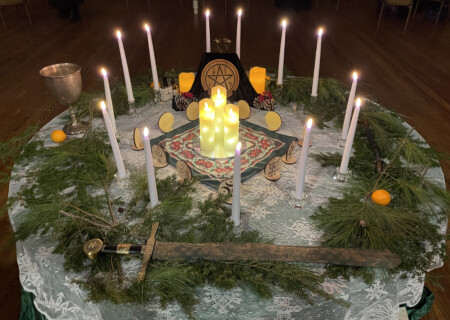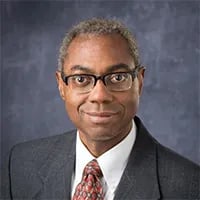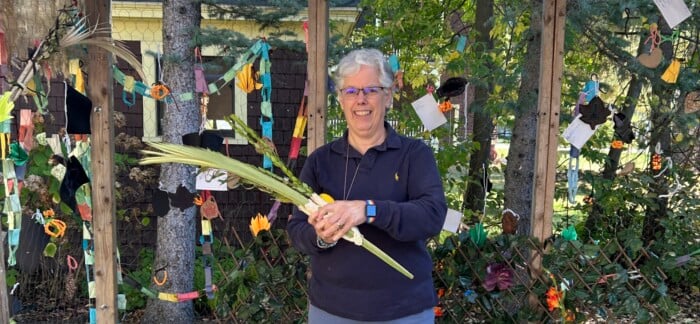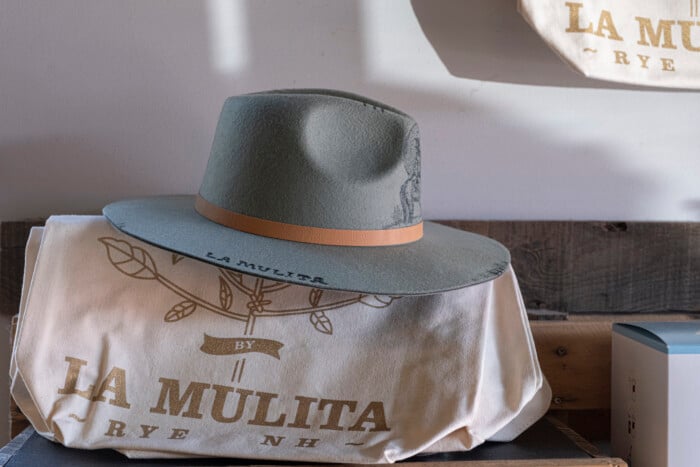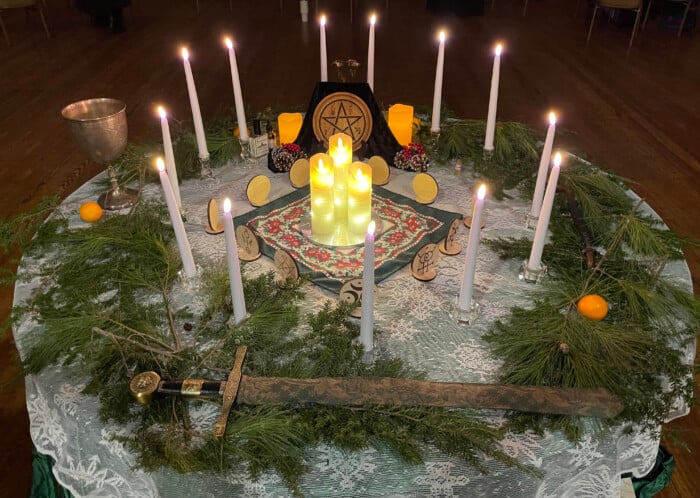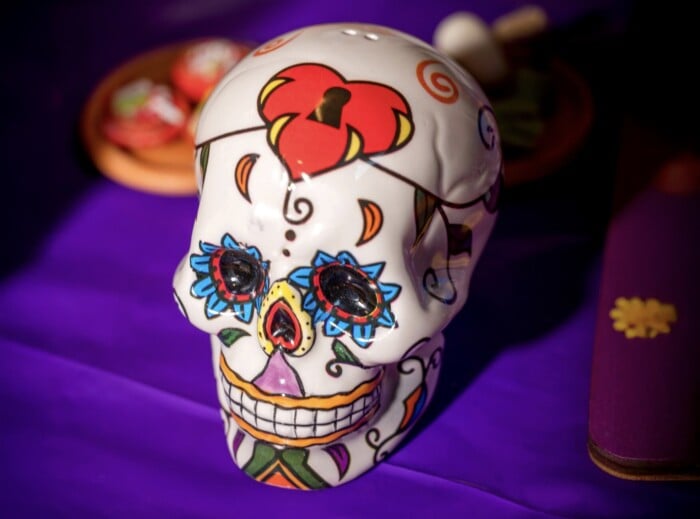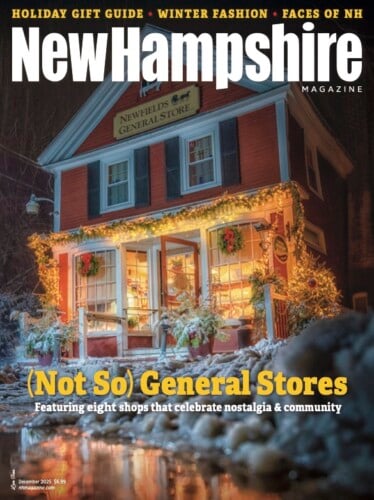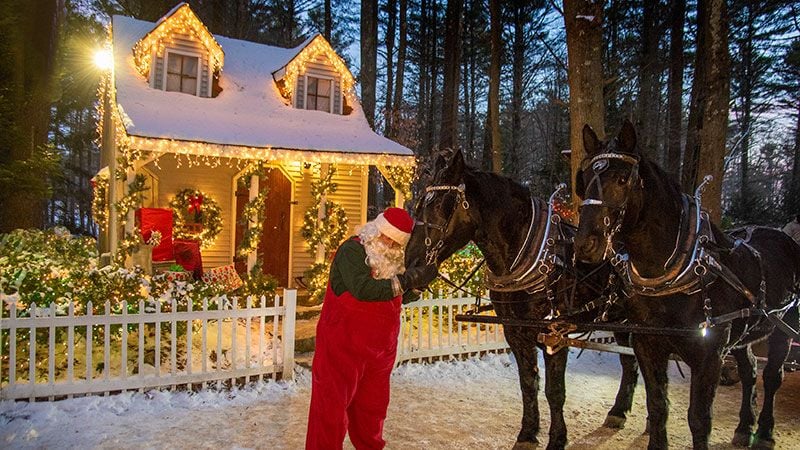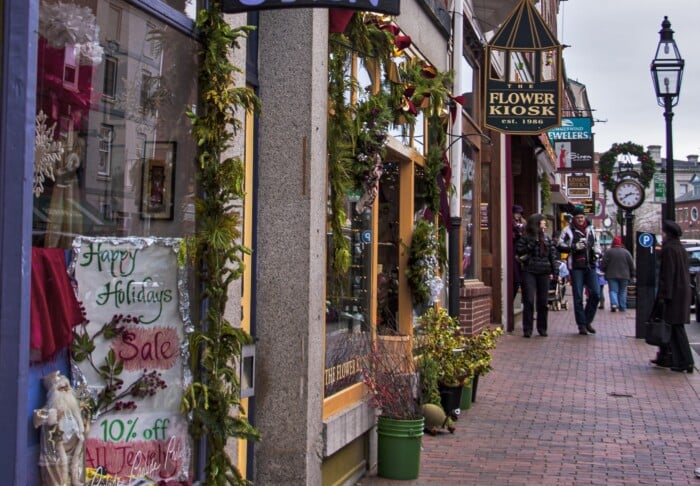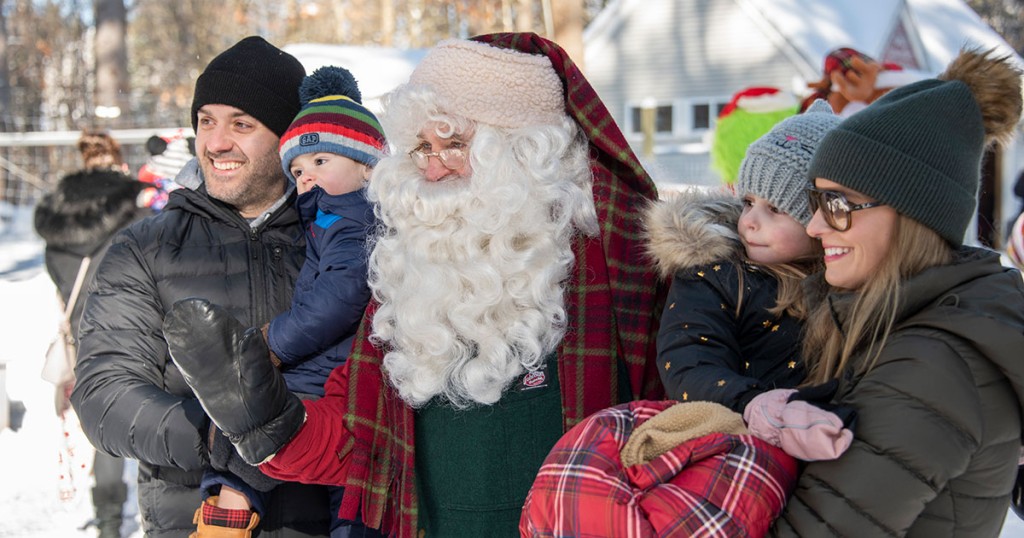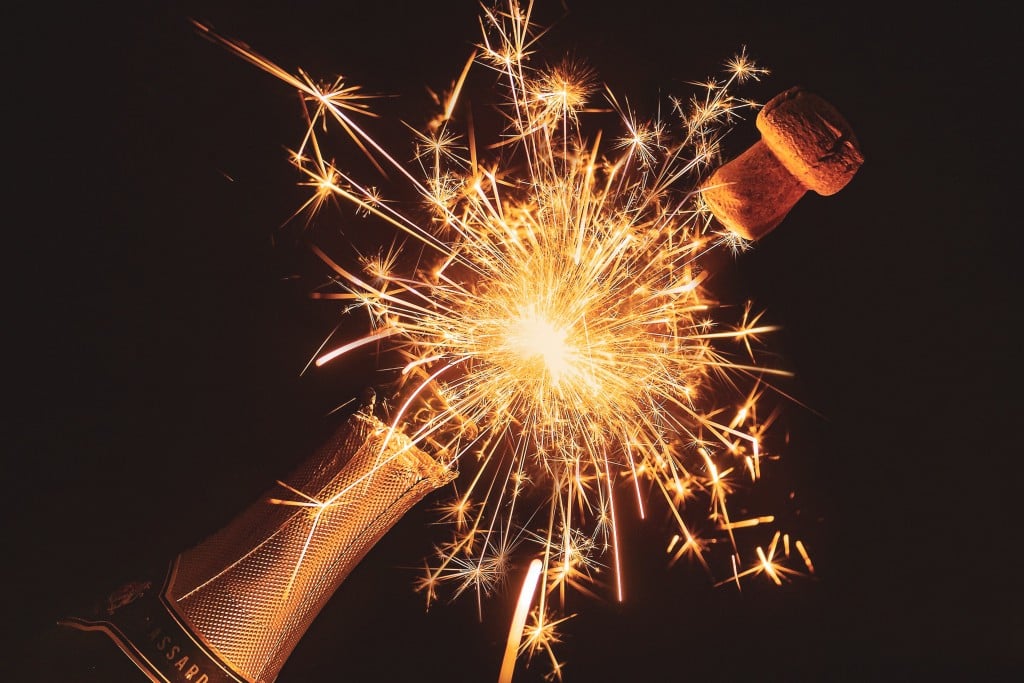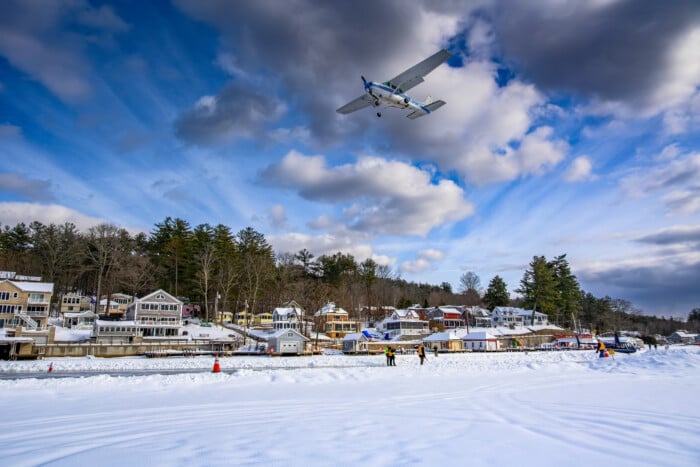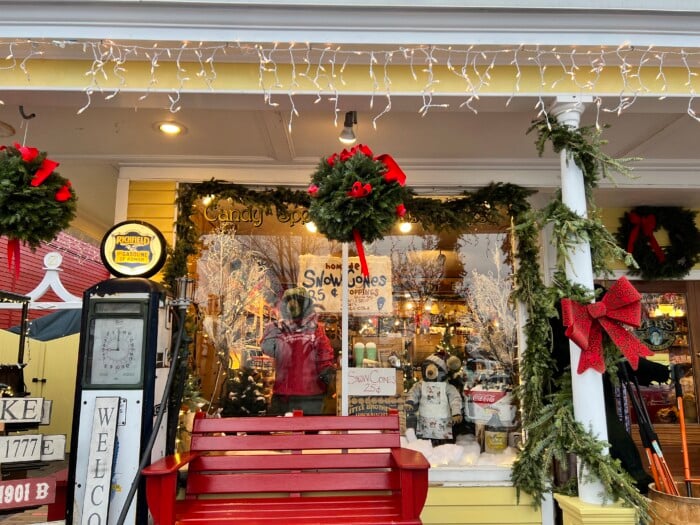Traditions that Unite Us: Rebirth of Light
Winter Solstice/Yule celebrates the return of the sun
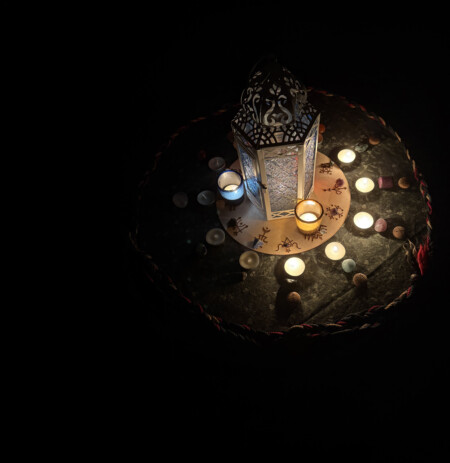
The altar used during a ceremony on the eve of Winter Solstice at the Masonic Hall in Salem, NH, by members of the Temple of Witchcraft. Photo by Steve Kenson
A candle is lit on the eve of the Winter Solstice and is kept glowing until sunrise, celebrating the return of the sun after the darkest night of the year. Yule also holds spiritual and magical significance. It is seen as a time when the veil between worlds is thin, making it easier to connect with spiritual energies, ancestors and deities.
This celestial event has been celebrated for centuries by various cultures, with Norse and Germanic roots. For pagans and Wiccans, Yule holds immense significance as a time of transition, rebirth and renewal.
This year, Winter Solstice and the beginning of the 13 days of Yule fall on Dec. 21 in the Northern Hemisphere.
But for members of the Temple of Witchcraft in Salem, NH, they will light a candle on Dec. 19 and celebrate the holiday on Dec. 20 at the Masonic Hall, also in Salem.
During Yule, some Temple members will join in an online meditation the night before, the eve of Winter Solstice.
“Our public, communal Yule celebration happens on or near the Winter Solstice, on the closest Saturday, since we need to rent the hall and have a time when the community can gather,” said Steve Kenson, Gemini lead minister of the Temple. “It is just one evening ritual, usually followed by a communal potluck.”
During the following days of Yule observation, members will celebrate at private or family events for those who choose to observe them. Pagan traditions for Yule center on celebrating the return of light, making plans for the coming year, and honoring nature and ancestors. In addition to candle-lighting, there may be divination practices, drumming or chanting circles, and group ceremonies to honor deities associated with the season.
“In the Temple of Witchcraft tradition, Witches celebrate ‘Mother’s Night’ on the eve of the Winter Solstice, reciting their matriarchal lineage as far back as they remember, and all the spiritual mothers in their life, as the Great Mother is about to give birth to the Sun Child,” said Christopher Penczak, the temple’s Sagittarius lead minister.
Then, for the next 12 days, they celebrate the 12 spirits of the zodiac, starting with Capricorn, as the sun enters the sign of Capricorn during the Winter Solstice, and ending on Sagittarius.
On these days, they do divinations with tarot cards, runes and other symbols, to give themselves a reading for each month of the coming year.
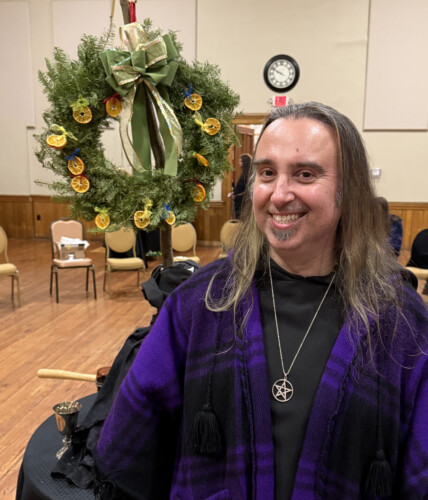
Christopher Penczak, one of the founders of the Temple of Witchcraft in Salem, NH. Photos by Steve Kenson
Founded by Kenson, Penczak and Adam Sartwell (Virgo lead minister), the Temple of Witchcraft started in 1998 as a system of magickal training and personal development, and eventually developed into a formal tradition of Witchcraft.
The temple has a range of 800 to 900 participants internationally. Approximately 300 to 400 of these may be education-based participants who are taking classes offered by the temple.
Now, as an outgrowth of the work of students, initiates and graduates of the programs, the Temple of Witchcraft has evolved into an organization based on traditions of modern magick, Witchcraft and neopaganism.
Penczak is its primary teacher and public ritualist as well as an author of numerous books. He explained that the zodiac sign of Sagittarius in his title aligns with his adventurous and spiritual strengths.
Born in Lawrence, Mass., in 1973, Penczak was raised in an Italian/Polish family while living in Salem, NH. After 12 years of Catholic school and becoming an avowed agnostic struggling with the intersection of his spirituality and queer sexuality, he initially pursued an interest in chemistry, stemming from a childhood fascination with alchemy and herbalism.
He attended the University of Massachusetts as a vocal major, earning a Bachelor of Music Performance/Music Business in 1995 and setting his sights on becoming a full-time performer.
While in college, a longtime friend and teacher introduced Penczak to the principles of Witchcraft, meditation, tarot and spell work. At first, he was skeptical, but his experience with a healing spell at a full moon ritual was enough to convince him that there was truth to these ideas, and he sought to understand more. He took classes with the Official Witch of Salem, Mass., Laurie Cabot, in her Cabot Tradition with an emphasis on Witchcraft as a science.
After graduation, Penczak began work at the A&R department of Fort Apache, a recording studio and record label in Cambridge, Mass.
Yet, he soon found himself leading meditations and ritual groups for friends seeking to know more about the craft. During his time in the Boston area, Christopher experimented with the ideas he later wrote about in his first published book “City Magick: Urban Rituals, Spells and Shamanism.”
Penczak explained that in addition to the candle burning all night during Winter Solstice Eve, there is a special altar set up that includes the four elements of earth, air, fire and water. Earth is represented by a stone; air by a sword; fire by a wand; and water by a cup. The altar can also hold candles, oil for consecration, incense, bells, frankincense and myrrh, and pine needles.
Key practices for the Winter Solstice include decorating with evergreen boughs and natural items, burning a Yule log for cleansing and new beginnings, holding feasts, decorating a Yule tree, and engaging in rituals of reflection and self-care, like staying up all night to welcome the sunrise.
“While it is customary to light an actual log, since we’re in the Masonic Hall, we light candles,” Penczak said.
Yule is also a time for gathering with loved ones and sharing a festive meal. Traditional foods include roasted meats, root vegetables, wassail (mulled wine or spiced cider), Yule log cakes, gingerbread and other seasonal treats. The feast is often accompanied by toasts, blessings and expressions of gratitude for the abundance of the season.
For more information about the Temple of Witchcraft in Salem, visit templeofwitchcraft.org
Yule Oilight
Shared by Christopher Penczak
½ ounce base oil such as olive oil or grape seed oil
12 drops of frankincense essential oil
5 drops of myrrh essential oil
4 drops of orange essential oil
3 drops of fir needle essential oil
2 drops of cedarwood essential oil
2 drops of wintergreen essential oil
1 drop of cinnamon leaf essential oil
1 drop of clove bud essential oil
Add drops of essential oils to the base oil, gently swirling each in with a clockwise swirling motion. Do a skin patch test in a small section of your skin to make sure the oils do not react to your skin. Anoint your wrists, brow and back of your head, where the spine and skull meet, to bless and protect yourself on the dark Winter Solstice night, and to evoke the blessings of the Sun. The oils used in this recipe can often be found at herbal shops, health food stores and at various herbal retailers online.
